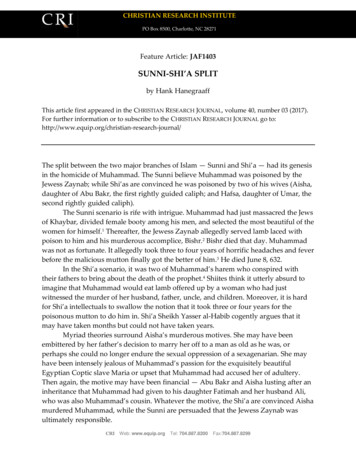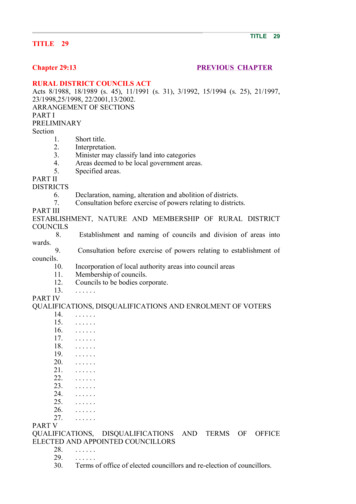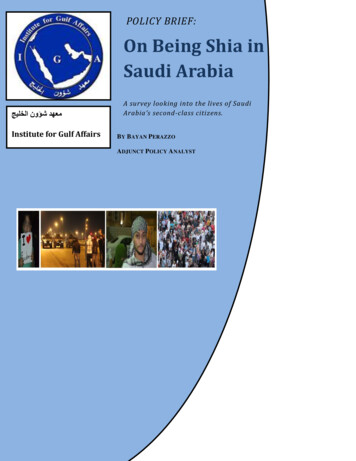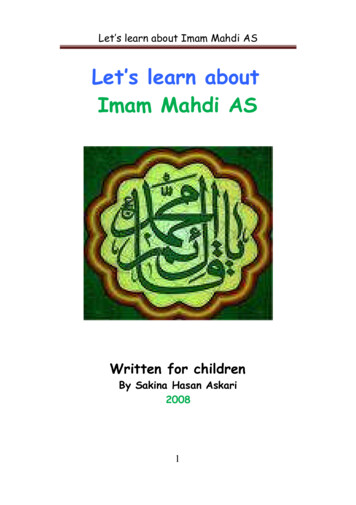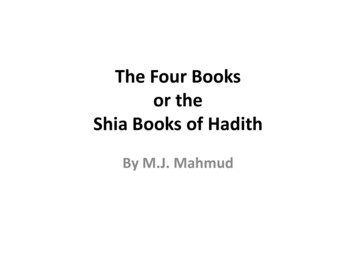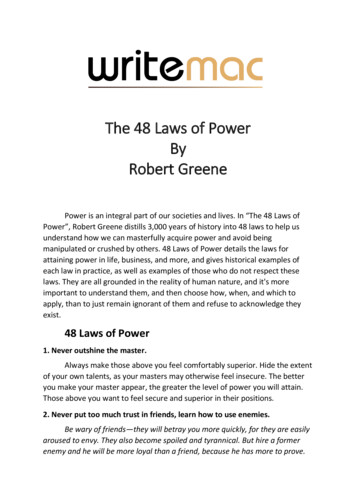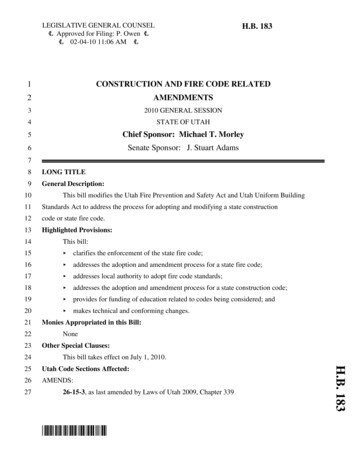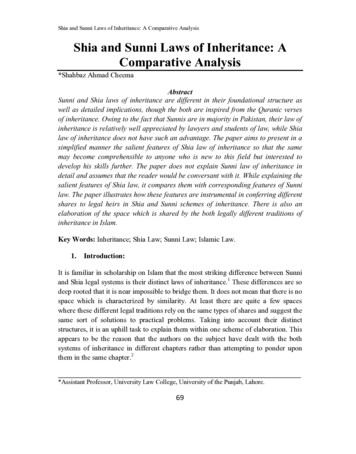
Transcription
Shia and Sunni Laws of Inheritance: A Comparative AnalysisShia and Sunni Laws of Inheritance: AComparative Analysis*Shahbaz Ahmad CheemaAbstractSunni and Shia laws of inheritance are different in their foundational structure aswell as detailed implications, though the both are inspired from the Quranic versesof inheritance. Owing to the fact that Sunnis are in majority in Pakistan, their law ofinheritance is relatively well appreciated by lawyers and students of law, while Shialaw of inheritance does not have such an advantage. The paper aims to present in asimplified manner the salient features of Shia law of inheritance so that the samemay become comprehensible to anyone who is new to this field but interested todevelop his skills further. The paper does not explain Sunni law of inheritance indetail and assumes that the reader would be conversant with it. While explaining thesalient features of Shia law, it compares them with corresponding features of Sunnilaw. The paper illustrates how these features are instrumental in conferring differentshares to legal heirs in Shia and Sunni schemes of inheritance. There is also anelaboration of the space which is shared by the both legally different traditions ofinheritance in Islam.Key Words: Inheritance; Shia Law; Sunni Law; Islamic Law.1.Introduction:It is familiar in scholarship on Islam that the most striking difference between Sunniand Shia legal systems is their distinct laws of inheritance.1 These differences are sodeep rooted that it is near impossible to bridge them. It does not mean that there is nospace which is characterized by similarity. At least there are quite a few spaceswhere these different legal traditions rely on the same types of shares and suggest thesame sort of solutions to practical problems. Taking into account their distinctstructures, it is an uphill task to explain them within one scheme of elaboration. Thisappears to be the reason that the authors on the subject have dealt with the bothsystems of inheritance in different chapters rather than attempting to ponder uponthem in the same chapter.2*Assistant Professor, University Law College, University of the Punjab, Lahore.69
Pakistan Journal of Islamic Research Vol 10, 2012Many Scholars have written on Shia and Sunni laws of inheritance, but theyhave either concentrated on the latter law or have not allocated appropriate space toelaboration of the former’s principles and their comparison with the latter’s law. Forinstance, one of the most renowned authors in the Muslim world on the subject AlSabooni in his book has restricted his analysis to Sunni law only.3 Pakistani lawyerof distinction has spared one chapter to discussion of Shia law of inheritance.4 LucyCarroll wrote two articles one each on Shia law and Sunni law of inheritance.5Though there are comparative insights in the above academic works, there is a needto present the comparative analysis holistically as well as in the simplest manner.The present paper is an attempt to present the subject in a comprehensible manner tothe new entrants. Moreover, the paper will also prove fruitful to the advanced levelof learners in the Islamic law of inheritance.The paper elaborates the general principles of Shia law of inheritance. Itdoes not detail Sunni law on the subject as its principles are relatively wellunderstood as compared to its Shia counterparts. During the course of elaboration, itpoints out various implications accrued by the application of Sunni and Shia laws ofinheritance to the same situation. It must be stated at the outset that the paper isintroductory in nature, and consequently, it cannot be expected to explicate the finedetails of Shia scheme of inheritance.In addition to this introduction and a conclusion, the paper is divided into sixsections. Each section will take up one feature of Shia law of inheritance and explainits implications along with comparative analysis of the corresponding feature ofSunni law. These features include classes of legal heirs, inheritance of spouses,principle of representation, rule of Radd/return, and principle of Aul/increase. Thepenultimate section will discuss how these differently structured systems ofinheritance lead to the same sort of answers in certain situations.2. Classes of Legal Heirs:Shia law divides legal heirs into three basic classes.6 These classes thereafterdetermine distribution of an estate among legal heirs and how to give preference toone legal heir over another. Appropriate appreciation of these classes helps one tounderstand Shia law of inheritance as details of the system in one manner or anotherare linked to it. These classes are the following:70
Shia and Sunni Laws of Inheritance: A Comparative AnalysisClass 1:(i) Parents, and(ii) Children (male and female). The children also include their descendantshow low so ever irrespective of the fact whether they are descendantsof male or female children.Class 2:(i) Grandparents (true or false) how high so ever, and(ii) Brothers and sisters (full, consanguine, and uterine) and their descendantshow low so ever irrespective of their gender.Class 3:(i) Paternal uncles and aunts,(ii) Maternal uncles and aunts, and(iii) Their children how low so ever irrespective of their gender.Once the heirs are divided into the above classes, there are two basic rules whichneed to be understood.7Firstly, as long as an heir (or more than one) is present from the class 1, no onewill be entitled to inheritance from the class 2: similarly, if there is an heir (or morethan one) from the class 2, no will have anything from the class 3. These classes laydown a basic framework in which an estate of a Shia deceased is distributed exceptthat deceased’s spouse is dealt with differently. We will take up this matter in thenext section.Secondly, within the same class there is no difference between male and femaleheirs except to the extent that a male heir will have double share than that of a femaleheir. For instance, descendants of a Sunni deceased’s daughter are excluded frominheritance as per Sunni law as they are regarded as distant kindred whose right toinheritance will only be entertained in absence of the sharers and the residuaries,8while his son’s descendants will be entitled to his estate as they are regarded as thesharer or the residuary. Shia law does not differentiate between descendants of sonand daughter and they are placed in the same class.9 When one descendant from theclass is entitled, the other would also have his/her share. Similar to descendants ofson and daughter, Sunni law divides descendants of brothers and sisters into theresiduaries and distant kindred respectively, while Shia law does not prefer malesover females in these situations nor place their descendants in different classes.An easy way to appreciate this divergence is to comprehend an importantdifference between Sunni and Shia laws. According to Sunni law, legal heirs aredivided into three classes, i.e. the sharers, the residuaries and the distant kindred;71
Pakistan Journal of Islamic Research Vol 10, 2012while Shia law recognizes only two classes, i.e. the sharers and the residuaries. Thereis no concept of distant kindred in Shia law.10 Most of those who are regarded asdistant kindred in Sunni law relate to a deceased from his female descendants (e.g.daughter’s children, son’s daughter’s children) or other female relatives (e.g.mother’s father, mother’s brother and sister, sister’s children etc.).11 As Shia lawplaces these females and their ascendants and descendants in above mentionedclasses along with their male counterparts, there remains no need to have anotherclass of legal heirs like the distant kindred in Shia scheme of inheritance.Another aspect we take into account while discussing Sunni law wasdistinguishing paternal and maternal grandfathers into true and false grandfathers.12As is apparent from the above classification, there is no such distinction in Shialaw.13 Both paternal and maternal grandfathers are placed in the same class. Againthis difference is an outcome of absence of the distant kindred in Shia scheme ofinheritance.The significance extended to the residuaries in Sunni law is not visible as suchin Shia law. Shia law has significantly reduced it by dividing the legal heirs into theabove classes. For instance, brother (one or more than one) is regarded as a residuaryin Sunni law in absence of deceased’s son (including son’s male descendants) andfather. It means that if a Sunni person dies leaving behind a daughter and a brother,the daughter will have half as a sharer while the rest will be inherited by the brotheras a residuary. If the same kind of situation arises with respect to a Shia person, thepersons in the class 1 will exclude those who are located in the class 2. This impliesthat the daughter will have the first half as a sharer while another half will be givento her under the principle of Radd/return.14The rule propounded by Sunni law that the nearest in degree will exclude thosewho are linked to a deceased by more remote relations15 is shared by Shia law ofinheritance. But the implications of this rule are quite different in the both systems.For instance, a true grandfather of remoter degree cannot be excluded by anygrandmother of nearer degree in Sunni law. It means that the grandfather’s fathercannot be excluded by the grandmother who is located a degree nearer to thedeceased. In Shia law, the grandmother excludes the grandfather’s father. The reasonfor this difference is that Shia law does not differentiate between males and femalesin excluding the remoter relations: female relatives are as effective in this regard asmale relatives are in Sunni law.1672
Shia and Sunni Laws of Inheritance: A Comparative AnalysisWe will observe the same kind of difference in outcome if a deceased leavesbehind a daughter and a grandson. In Sunni law, the daughter will have half of theestate while the rest will be inherited by the grandson as a residuary. The situationwill be different in Shia law because of variant application of the rule the nearer indegree will exclude the remoter in degree. The daughter is located a degree nearer tothe deceased as compared to the grandson. So, she will have the entire estate: thefirst half as a sharer while another half under the principle of Radd/return.Shia law is similar with Sunni law to some extent and dissimilar to anotherextent with respect to distribution of an estate among brothers of different kinds, i.e.full, consanguine and uterine. Full brother excludes consanguine brother, but neitherfull nor consanguine brother exclude uterine brother. In Sunni law, full sister doesnot exclude consanguine brother except in a situation where the former is convertedinto Ausbaat ma’a Ghayr (the residuaries together with another).17 Shia law isdifferent from Sunni law on this point as full sister excludes consanguine brothergenerally because the former’s status is equivalent to her male counterpart in hisabsence.Some schools of Sunni law do not award any share to deceased’s brothers andsisters in presence of true grandfather owing to the reason that the former steps intothe shoes of the father in case of his death.18 According to Shia law, grandparentsand brothers/sisters are all located in the same class; hence, none of them will beinstrumental in excluding others.19As far as the class 3 of legal heirs in Shia law is concerned which includespaternal and maternal uncles and aunts and their descendants, there is no preferenceon the basis that someone is linked to a deceased from paternal or maternal side. Aslong as deceased’s heirs are situated at the same degree of relationship, they willhave share in inheritance irrespective of their gender and origin of their relationshipto a deceased.20 For instance, a person dies leaving behind one paternal uncle andanother maternal uncle. The both will be entitled to inheritance and the paternaluncle will not have any preference over the maternal uncle, though their shares willnot be the same. But if the same situation is solved according to Sunni law, thepaternal uncle will inherit the entire estate as a residuary, while the maternal unclewill not have any share in the estate as he is regarded as distant kindred.73
Pakistan Journal of Islamic Research Vol 10, 20123. Inheritance of Spouses:As is apparent from the above three-fold classification of heirs in Shia law, spousesare not placed in anyone of them. The above referred classes are jointly known asheirs by consanguinity in Shia law, while spouses are termed as heirs by affinity.21The heirs by consanguinity are also termed as heirs by Nasab, while the heirs byaffinity are heirs by Sabab.22 Thus, husband and wife form an independent categorysimilar to Sunni law which is only affected by presence or absence of deceased’schildren. If there are children of a deceased, husband or wife will inherit 1/4 or 1/8respectively. But if a deceased dies issueless, husband or wife will have 1/2 or 1/4respectively. If a deceased husband leaves behind more than one wife as legal heirs,they will share jointly in their prescribed share, i.e. 1/4 or 1/8.23There are a few differences between Sunni and Shia laws regarding inheritanceof spouses. Some Shia schools recognise temporary marriage as a valid marriage.According these schools, only permanently married spouses are entitled to right ofinheritance from each other.24 There is one important distinction between Shia andSunni laws regarding the inheritance of childless widow. In the former law, she isnot entitled to land or immovable property though she has a right to her prescribedshare from her deceased husband’s movable assets.25 On the other hand, Sunni lawdoes not differentiate between immovable and movable properties of a deceased;hence, a childless widow is entitled to have her share from the both.In Sunni law, spouses do not benefit under the principle of Radd/return in thefirst place, i.e. in presence of other sharers. The same is the rule under Shia law.26For instance, if a person dies leaving behind his wife and a daughter, the wife willinherit 1/8, and 7/8 will be given to the daughter (one half as a sharer and the restunder the Radd).4. Principle of Representation:Without getting into technicalities of what is meant by principle of representation,this section explains another fundamental difference between Shia and Sunni laws ofinheritance as to how an estate should be distributed among heirs of a predeceasedheir. There is no difference between the both laws that heirs of a predeceased heirwill not inherit anything if other heirs of the deceased are alive.27 For instance, if aperson dies leaving behind one son and two grandsons of a predeceased son, the sonwill get the whole estate and nothing will be given to the grandsons. Thus, theprinciple of representation has no relevance when there are other heirs alive from thesame class who are also a degree nearer as compared to the descendants ofpredeceased heir. The classical law of these schools, which is being discussed in thissection, is different from the law applicable in this regard in Pakistan under Sec. 4 ofthe Muslim Family Laws Ordinance, 1961.2874
Shia and Sunni Laws of Inheritance: A Comparative AnalysisThe occasion for application of representation arises when there aredescendants of predeceased heir (one or more than one) without there being anydirect descendent of the deceased alive. Shia and Sunni classical laws are inagreement on this point again, but they differ as to the manner of distribution of anestate among such heirs.29 For instance, a person dies leaving behind three grandsonsof two predeceased sons (two grandsons from one son and the third from another)without there being any other son or daughter alive. They will be entitled toinheritance.Now the question arises as to the manner of distribution among such heirs.According to Sunni law, all grandsons will inherit from the estate of theirgrandparent as per capita: which implies that it will not be taken into account howmany out of those grandsons have descended from a particular predeceased heir. So,each grandson will inherit 1/3 of the estate as if they are individually entitled toinheritance.30 According to Shia law, the distribution is carried out per stripes (as perstocks): which implies that each son would have his individual share had he beenalive which will be further divided to his legal heirs.31 So, the descendants ofpredeceased sons are not regarded as individually qualified legal heirs; they merelyrepresent their parents. They will only have what their parents would have inheritedhad they been alive. In the above example, two grandsons are linked to the deceasedgrandparent by the same father, so their share will be half than that of the thirdgrandson as he is the only heir of his father whom he represents.While explaining the principle of representation above, we haveintentionally skipped two important issues to avoid any confusion. These are thefollowing:Firstly, the situation in Shia law will not be very different had there been inthe above example two grandsons from the predeceased son and one grandson fromthe predeceased daughter as paternal and maternal grandchildren are entitled toinheritance.32 In Sunni law the maternal grandson is regarded as distant kindred andis only entitled to inherit in absence of the sharers and the residuaries.33 So, he doesnot have anything in this case as there are the residuaries, i.e. the paternal grandsons,who are preferred over him. The only difference with respect to the inheritance ofpaternal and maternal grandchildren in Shia law is that the children of daughter taketheir shares from the share of their mother, while the paternal grandchildrenrepresent their father, and consequently, inherit from his share. The distribution75
Pakistan Journal of Islamic Research Vol 10, 2012among grandchildren of the same parent is carried out on the basis of double sharefor a male than that of a female heir.Secondly, the principle of representation is also applicable to heirs of othercategories in Shia law, e.g. descendants of collaterals (brothers and sisters),descendants of uncles and aunts on the basis of the same rules we have justelaborated regarding children of predeceased children of a propositus.345. Rule of Radd/Return:When an entire estate of a Shia Muslim is not consumed by his/her heirs andsomething is left out of it, the rule of Radd/return is applied as is done in Sunni law.The application of Radd is more frequent in Shia law because it accords lesssignificance to Ausbaat/residuaries as compared to Sunni law.35 In Sunni law anexhaustive list of the residuaries reduces the occurrences of application of Radd.Whenever there is residue of an estate of a deceased Sunni Muslim that will be givento any eligible residuary irrespective of the fact how remotely he is related to thedeceased. 36 While such an exhaustive list is not available in Shia law and even thosewho are regarded as the residuaries they cannot operate beyond the sphere of theirown basic class.For example, deceased’s paternal uncle is a residuary in Sunni law and hewill be entitled to inheritance after the distribution of prescribed shares to thesharers. Suppose a person dies leaving behind a daughter and his paternal uncle. Asper Sunni law, the daughter will have one half, while the rest will be inherited by hisuncle. But if the deceased is a Shia Muslim, his daughter will take the entire estatethe first half as a sharer and another half after applying the Radd. The reason for thissort of distribution is that the daughter belongs to the class 1 and the uncle is an heirlocated in the class 3. The uncle is only entitled to inheritance if there is no heir fromthe class 1 & 2.Let us explain another example to appreciate how the role ofAusbaat/residuaries is restricted in Shia law to allow more space to the application ofRadd. If a person dies leaving behind his father and a daughter. According to Sunnilaw, the daughter will get one half and the rest will be inherited by the father as aresiduary. In Shia law, a father is not regarded as a residuary in presence ofdeceased’s daughter as the both are placed in the same class. Thus, in the aboveexample, the father and the daughter will first inherit as sharers and the residue willbe shared by them under the Radd in accordance with their respective shares.76
Shia and Sunni Laws of Inheritance: A Comparative AnalysisFather 1/6,Daughter 1/2,LCM 6,Father 1/6,Daughter 3/6,After applying the Radd:Father 1/4,Daughter 3/4.In Sunni law, spouses are not entitled to any benefit under Radd except in a casewhere there is no other relative of deceased alive including distant kindred.37 Shialaw has added into this list two more persons: the one is mother and the other isuterine brother/sister. Under certain circumstances, they are only restricted to theirprescribed share.38 There is no need to go into detail of those circumstances as thepaper is meant to be introductory.6. Principle of Aul/Increase:The principle of Aul is not recognized in Shia law of inheritance and Shia scholarshave expounded rules to avoid its application.39 In Sunni law, whenever thecalculated shares of heirs of a deceased are increased from the supposed shares ofthat estate, the supposed shares are increased to match the number of the calculatedshares. In this manner, each sharer gets what is prescribed for him/her in the Quranin terms of numbers, though the actual amount/quantity of his/her share is reduced.40As it is not possible to avoid situations which attract the application of principle ofAul, Shia jurists have devised an innovative manner to resolve such situations. Theyhave divided the sharers of a deceased into those whose share is susceptible toreduction and those whose share is not liable to reduction.41 They have placeddaughters and sisters into the first category taking into account the fact that theirprescribed shares (one half and two thirds) could be reduced in those situationswhere there is a male counterpart who converts them into residuaries. On the otherhand, there are other sharers, e.g. parents, spouse and uterine sister, whose share isminimally prescribed in the Quran which could not be reduced from that minimalamount in any case. 42 So, if there are heirs from both these categories and theircalculated shares are increased from the supposed shares, the heirs of the secondcategory will have their prescribed shares, while the heirs of the first category willbear the burden of avoidance of application of the principle of Aul.Let us explain this in an illustration. A female dies leaving behind her husbandand two sisters. The husband’s prescribed share in such a situation is 1/2, while twosisters’ 2/3. If we solve this proposition, the husband will be entitled to 3/6 and the77
Pakistan Journal of Islamic Research Vol 10, 2012sisters 4/6. So, according to Sunni law, the Aul will be applied to make the husband’sshare 3/7 and the sisters 4/7. But Shia law resolves it differently by proposing thatthe husband should be given 3/6 as his prescribed share is not susceptible toreduction, while the sisters will jointly inherit 3/6 instead of 4/6 as their share can bereduced to circumvent the application of Aul.7. Similarities in Shia and Sunni Laws:Shia and Sunni laws of inheritance are characterized by multi-layered differences asexplained above. There are some similarities between them due to the fact that theboth laws are derived from the same Quranic verses. Some of the similarities havealready been pointed out in the preceding analysis while explaining the true importof distinctive features of Shia law. These laws are on the same page as to who areQuranic sharers, they agree on their prescribed shares and conditions under whichtheir entitlement is regulated to a large extent. There are twelve sharers according toSunni law out of which Shia law recognizes nine sharers.43 The agreed upon sharersare: husband, wife, father, mother, daughter, full sister, consanguine sister, uterinebrother and uterine sister.44These legal traditions differ with each other on three persons’ status assharers: son’s daughter, true grandfather and true grandmother. According to Sunnilaw, they are included in Quranic sharers as they step into the shoes of daughter,father and mother respectively in their absence. According to Shia law, son’sdaughter may inherit when there is no son and daughter of the deceased alive, butshe is not a Quranic sharer as regarded by Sunni law. Moreover, true grandparentsare placed by Shia law in the class 2 along with false grandparents and theirinheritance is dependent on absence of heirs of the class 1.Taking into account the agreement on nine sharers by Sunni and Shia laws,one may expect that there will be situations in which both laws suggest the same sortof distribution of shares. Let us explain it by elaborating some examples.a). A husband dies leaving behind a widow and a son. The widow will have herprescribed share of 1/8, while the son will have the residue of the estate.Wife/widow 1/8 as a sharer,Son 7/8 as a residuary.b). A wife dies leaving behind her husband and a full sister. The husband and the fullsister will get half of the estate each as sharers in both Shia and Sunni laws.78
Shia and Sunni Laws of Inheritance: A Comparative AnalysisHusband 1/2 as a sharer,Full sister 1/2 as a sharer.c). A person dies and leaves behind his wife and a full brother. His wife will get 1/4as a sharer, while the rest, i.e. 3/4 will be inherited by the full brother as a residuaryin both Shia and Sunni laws.Wife 1/4 as a sharer,Full brother 3/4 as a residuary.d). A wife dies leaving behind her husband and one full brother and one full sister.The husband will have one half of the estate and the rest will be divided between thefull brother and the full sister in both Shia and Sunni laws. The full brother will getdouble than that of the full sister.Husband 1/2 as a sharer,Full brother & full sister 1/2 as residuaries,The proposition will be solved from 6 supposed shares.Husband 3/6,Full brother 2/6,Full sister 1/6.8. Conclusion:The paper has explained the basic features of Shia law of inheritance and comparedthem with the corresponding principles of Sunni law with a hope to engender properappreciation of this area of law among the legal fraternity including students of law.It has been brought to forth that if some structural aspects of Shia and Sunni laws aregrasped, it would become relatively easy to master these systems. For instance,division of legal heirs into three classes according to Shia law does not have anycomparable feature in Sunni law. As illustrated above, this difference has manifoldimplications in determination of shares of legal heirs. There is another noteworthydistinction that Shia law does not recognize distant kindred as another category oflegal heirs as they are identified in Sunni law. Most of those who are classed asdistant kindred in Sunni law, they are absorbed in the three basic classes of Shia law.Hence, they are eligible to inherit an estate either as a sharer or a residuary.Moreover, Shia law erects its foundational rules in such a manner to exclude anypossibility of Aul to take place: whereas the same principle is frequently resorted toin Sunni law. As these schemes of inheritance in Islamic law are inspired from the79
Pakistan Journal of Islamic Research Vol 10, 2012verses of the Quran, they are expected to be similar in certain respects. We observethat the both systems recognize same persons as the sharers and the residuary thoughthey differ in calculation of their respective shares in numerous circumstances. Itmust be admitted after comparing the both systems that the space characterized bysimilarity is too small in comparison to the area where Shia and Sunni laws havedifferent solutions to the same problems.References:1Coulson, N.J. Succession in the Muslim Family (Cambridge University Press,London 1971), p. 108.2For instance, see the following books.(a) Verma, B. R. Mohammaden Law in India and Pakistan (Law Book Co.,Allahabad 1962) pp. 289-393.(b) Purohit, N. The Principles of Mohammedan Law (2nd Edition) (Orient PublishingCompany, New Delhi 1998) pp. 432-541.(c) Ameer Ali Commentaries on Mahommedan Law (Revised by S. H. A. Raza)(Hind Publishing House, Allahabad 2004) pp. 985-1124.(d) Fyzee, A. A. A. Outlines of Muhammadan Law (Edited by Tahir Mahmood)(Oxford University Press, New Delhi 2009) pp. 304-369.(e) Mulla, D. F. Principles of Mahomedan Law (Edited by Dr. M. A. Mannan) (P. L.D. Publishers, Lahore 1995) pp.65-180.3Al-Sabooni, M. A. Al-Muwarith fi al-Shariah al-Islamia fi Zuo al-Kitab ws Sunnah(Inheritance in Islamic Shariah in light of the Quran and Sunnah) (Dar-ul-Qalam,Damascus).4Khan, H. The Islamic Law of Inheritance: A Comparative Study of Recent Reformsin Muslim Countries (Oxford University Press, Karachi 2007).5Carroll, L. The Ithna Ashari Law of Intestate Succession: An Introduction to ShiaLaw Applicable in South Asia (Modern Asian Studies, Vol. 19, No. 1. 1985);Carroll, L. The Hanafi Law of Intestate Succession: A Simplified Approach (ModernAsian Studies, Vol. 17, No. 4. 1983).6Mulla, Principles of Mahomedan Law, p.152-153. Fyzee, Outlines ofMuhammadan Law, p. 354-362. See also Khan, H. The Islamic Law of Inheritance,pp.124-139.7Carroll, L. The Ithna Ashari Law of Intestate Succession, pp.86-89.8Al-Sabooni, M. A. Al-Muwarith fi al-Shariah al-Islamia fi Zuo al-Kitab ws Sunnah,p.37-38.9Carroll, The Ithna Ashari Law of Intestate Succession, p.87.10Ajijola, A. D. Introduction to Islamic Law (International Islamic Publishers,Karachi 1983) p.266.11Khan, The Islamic Law of Inheritance, p.97.80
Shia and Sunni Laws of Inheritance: A Comparative Analysis12Al-Sabooni, Al-Muwarith fi al-Shariah al-Islamia fi Zuo al-Kitab ws Sunnah;Mulla, Principles of Mahomedan Law, p.90.13C
Shia law divides legal 6heirs into three basic classes. These classes thereafter determine distribution of an estate among legal heirs and how to give preference to one legal heir over another. Appropriate appreciation of these classes helps one to understand Shia law of inheritance as details of the system in one manner or another are linked .


